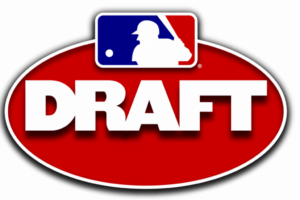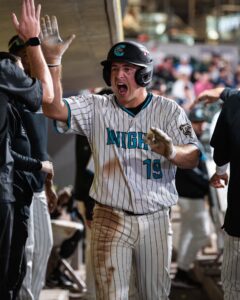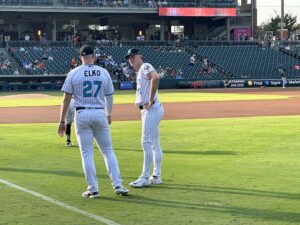Are Pioneer League stats for first year pros predictive? Aaron Schnurbusch vs history
This time of year, people who follow prospects start to ask about the year’s draftees that are tearing up rookie leagues. This is especially true if the player wasn’t a high round pick. Is this guy a prospect? Why hasn’t such-and-such been promoted yet? How did this dude fall to such a low round?
The first, most obvious and generally true response is that stats in rookie ball need to be taken with a heaping pile of salt. There are a wide range of important contextual factors at play. That’s not to say that all rookie ball stats should go out the window – but it is accurate to say that they need a lot of context, and shouldn’t be relied upon heavily for evaluation.
This year, the White Sox prospect getting the most attention for a surprise statistical performance in the Pioneer League is 28th round pick Aaron Schnurbusch. All three of the theoretical questions in this article’s first paragraph have been asked of us, multiple times, regarding this outfielder. They are asking because he’s been putting up pretty beastly numbers so far for the Voyagers: .375/.472/.582, 12 2B, 4 3B, 6 HR and 11/12 SB/ATT to boot in his first 48 games (218 PA). He was hitting near or over .400 until just a week or two ago.
Do those numbers mean anything?
Important caveat: I have not yet seen Schnurbusch play in person. I’ve gathered a couple local reports from non-scouting types, and he’s been interviewed in a couple publications, but that’s not a lot to go on. So why not explore the stat path for now, just for fun?
Here is the question I will attempt to answer: Does Aaron Schnurbusch’s performance in Great Falls thus far have any predictive value?
To answer, let’s compare his performance against history. The White Sox have had Great Falls as an affiliate since 2003, sending mostly the more polished recent draft picks to Big Sky country (high school picks usually went to Bristol/AZL). The Pioneer League is a hitter-friendly environment too, so there should be some big statistical performances over the years to look at. Below is a chart of every White Sox minor leaguer who in their draft year posted an OPS of at least .900 with at least 100 plate appearances with Great Falls over those 14 seasons…
| Year | Player | Age | Round | PA | AVG | OBP | SLG | OPS |
| 2016* | Aaron Schnurbusch | 22 | 28th | 218 | .375 | .472 | .582 | 1.054 |
| 2014 | Jake Peter | 21 | 7th | 171 | .388 | .444 | .579 | 1.023 |
| 2011 | Kevan Smith | 22/23 | 7th | 127 | .318 | .417 | .523 | .941 |
| 2010 | Mike Blanke | 21 | 14th | 271 | .329 | .400 | .508 | .908 |
| 2008 | Tyler Kuhn | 21 | 15th | 280 | .375 | .424 | .570 | .995 |
| 2007 | Jim Gallagher | 21/22 | 7th | 295 | .332 | .418 | .534 | .953 |
A few things immediately jump out on this list:
- Just six players who did that in 14 years seems like a pretty small number. But keep in mind that some players like Jacob May and Keenyn Walker were putting up similar numbers and were quickly promoted to Kannapolis before reaching 100 PA. The fact that Schnurbusch hasn’t been promoted as quickly could be an indicator in itself, though it is effected by outside circumstances (Kannapolis’ outfield currently has three legit prospects, so there’s no room at the moment).
- None of the three retired players (Blanke, Kuhn, Gallagher) ever reached the majors.
- The two still playing (Peter and Smith) are still prospects and both have a good shot to see Chicago this year or next, though neither are looked at as likely full-time players in the majors.
- None of those players were very high picks, but three were within the top 10 rounds and Schnurbusch is certainly an outlier in terms of draft round among this group.
- Fans of the Voyagers should be excited any time a 7th rounder shows up on the roster.
Overall, the list isn’t showing a lot of big time prospects. But every name on there (prior to this year) was at some point on a FutureSox Top 25/30 list, so all of them were looked at as having some potential as a pro. Schnurbusch’s numbers are at or near the top in all three slash line categories.
Now let’s take that same group and look at some peripheral numbers that may give us deeper clues into what is going on here…
| Year | Player | K/PA | BB/PA | Iso SLG | BABIP |
| 2016* | Aaron Schnurbusch | 24.3% | 14.2% | .207 | .504 |
| 2014 | Jake Peter | 7.6% | 7.6% | .191 | .410 |
| 2011 | Kevan Smith | 12.6% | 11.0% | .205 | .356 |
| 2010 | Mike Blanke | 12.2% | 8.5% | .179 | .358 |
| 2008 | Tyler Kuhn | 12.5% | 7.5% | .195 | .427 |
| 2007 | Jim Gallagher | 12.9% | 11.9% | .202 | .354 |
Now on this chart, some big differences appear. There are two red flags for Schnurbusch here. First, he’s striking out at double (or more) the rate of the rest of those hitters. His 24.3% is a high though not scary-high number for a rookie pro, but it is much higher than the parallel examples. Second is that insanely high .504 BABIP, which is unsustainable. Not only will no one maintain a BABIP like that for long, it’s also .129 higher than his average thanks to that strikeout rate. A number that high indicates he’s hitting the ball hard AND getting quite a bit of good luck that won’t last. He’s got some speed which sometimes inflates that measure, but even Billy Hamilton doesn’t have enough for his BABIP to be that high.
On the flip side, there are a couple positives to note too. His walk rate is also very high, so we can at least assume he’s not super-aggressive at the plate. Pitchers will need to come to him, and hitters who are more patient at the plate tend to better handle level jumps as they develop. Also, that .207 Iso is a very nice number, and he’s not just getting it from speed-driven extra bases (he has 6 home runs). This is another indicator that it’s likely he’s making hard contact a fair amount of the time.
There isn’t a truly good comp to make among the group with Aaron. None have struck out or walked nearly that often, or sustained that kind of average on balls in play for that long.
The Verdict
As for what a big offensive season for a first year pro in the Pioneer League means, the answer appears to be, not a lot. It seems safe to say that prospects who perform in this band are likely to at least play serviceable ball into the upper levels of the minors. And for a 28th round pick like Schnurbusch, that’s better than average. It certainly isn’t a negative indicator either – Peter and Smith (especially the former) are probably major leaguers within the next year or so.
As alluded to earlier, we need some in-person reports to really get to know who Aaron Schnurbusch is as a player. The reports we do have indicate he gets to everything with the glove, and has a strong arm (but sometimes gets jumpy with throws). Steve Schreck of the Great Falls Tribune reports that he simplified his approach and swing as well, which could be a reason for his improvement since college.
The stats tell a split story. The positives are that high walk rate and the patience it may indicate, and some significant game power. But his BABIP and strikeout rate fairly scream regression candidate. In his case, even with some of that luck turning south, he is still likely to have a season that will rank among the best for hitters in recent Voyagers history. That shouldn’t be ignored outright, so he’s definitely worthy of some attention.
We won’t know how solidly the word “prospect” really fits until Schnurbusch faces full season league pitching. But for now, I feel safe saying he should at least be in the team photo in this system. I won’t get overly excited just yet, but even with the red flags, I wouldn’t dismiss him either. We’ll be watching Aaron in 2017.
Want to know right away when we publish a new article? Type your email address in the box and click the “create subscription” button. Our list is completely spam free, and you can opt out at any time.






